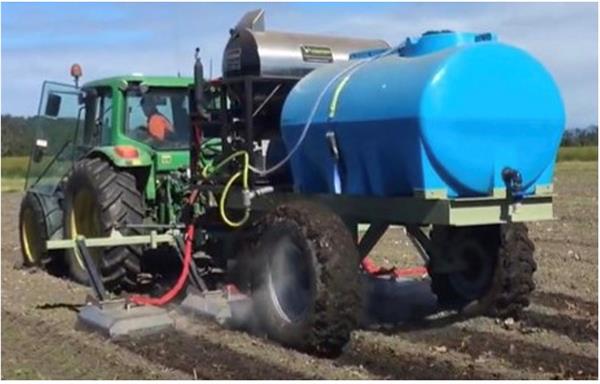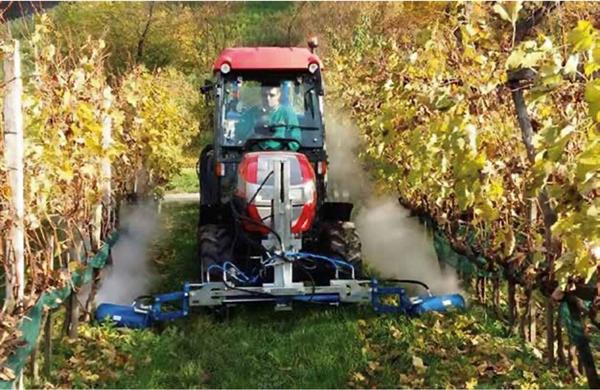Vol. 13, Issue 2, Published 1/26/2022
Public health and environmental concerns about the use of herbicides in addition to the rise in the number of herbicide resistant weeds has led to increased interest in non-chemical methods for weed control. Steam application is one technique that is gaining popularity as an alternative to applying glyphosate and other herbicides in public areas such as parks and school yards. Steam kills weeds by heating plant tissue to levels sufficient to rupture plant cell walls. As you might imagine, the method is energy intensive and slow. To kill even small weeds, exposure to superheated steam for several seconds (2-4) is required (Upadhyaya et al. 1983).
Steam is also used to control weeds in commercial agriculture. There are several manufactures of equipment designed for use in orchards, vineyards and even row crops (Fig. 1-2) (M.M. S.r.l., Modena, Italy; WeedTechnics, Terry Hills, NSW, Australia). These types of machines are equipped with high powered steam generators (200 HP) that convert water to steam at a rate of about 170 gal/hr. Recommended travel speeds are 1-2 mph depending on weed species and density. For orchards and vineyards, steam is typically applied in bands using steam hoods mounted on arms that extend to the crop row (Fig 2).
Despite being organically compliant and indifferent to herbicide resistant weeds, use of steam for post emergence weed control in commercial agriculture has seen limited adoption. A major limitation is that steam provides only partial weed control. Large, susceptible weeds die back, but tend to regrow 3-4 weeks after application and follow up applications are required. Further, some weed species are tolerant to steam when applied at reasonable travel speeds and rates. Abdulridha et al. (2019) investigated the use of steam for weed management in citrus. At travel speeds of 1 mph, goatweed and sedges were controlled (>72%), but Florida pusley and guinea grass were not (< 36%). Other researchers reached similar conclusions; although steam treatment is effective on small weeds (2 true leaves or smaller), control of large weeds is highly dependent on weed species with mortality rates ranging from 100% to 0% (Merfield et al. 2017).
Except for some very specific circumstances, use of steam for post emergence weed control is probably best left to urban areas where cost and time required for application are not as critical as they are in commercial agriculture.
References
Abdulridha, J.J., Kanissery, R.G., McAvoy, C.E. & Ampatzidis, Y.G. Evaluation of steam application for weed management in citrus. Appl. Eng. in Agric.,35(5): 805-814.
Merfield, C.N., Hampton, J.G. & Wratten, S.D. 2017. Efficacy of heat for weed control varies with heat source, tractor speed, weed species and size. New Zealand J. Agric. Res., 60(4): 437-448.
Upadhyaya, M.K., Polster, D.F. and Klassen, M.J. 1993. Weed control by superheated steam. WSSA Abstracts, 33, 115.

Fig. 1. Applying steam post emergent weed control. (Photo credits: Weedtechnics).

Fig. 2. Applying steam to organically control weeds in a vineyard. (Photo credits: M.M. S.r.l).





